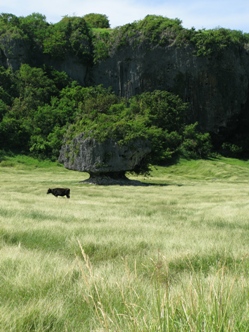
The Earth’s continental margins appear to be in a state of continuous uplift. Disentangling all the evidence however has proved a mind-boggling task, reports Ted Nield
The largest global analysis of sea-level data ever attempted suggests that continental margins have risen on average by more than 0.2 mm per year – four times faster than the estimated drop in global sea levels since the last interglacial stage. This uplift occurs fastest at active margins (c. 0.36mm/yr), but is also happening (at 0.13mm/yr) along passive margins, like those surrounding the Atlantic Ocean. Kevin Pedoja (CNRS, Université de Caen) and co-authors conclude that the global uplift can only be explained by plate tectonic processes.
Image: Uplifted limestones and marine erosion features along a constructional (reefal) shoreline on a passive tectonic margin (Barbados). Photo: Ted Nield.
As the dispersing fragments of Pangaea begin to re-connect with one another, compressive stress tends continually to build up within in the lithosphere. This happens because as collisions occur, the total length of destructive margin, where stress is relieved, decreases - while the total length of spreading ridge remains steady. This creates a global compressive stress regime that causes uplift even along passive margins. Uplifted shorelines the world over have been noted since such pioneers as Darwin and Lyell.
HIGHSTAND
Pedoja et al. decided to test their hypothesis using the well-known sea-level highstand marking the last interglacial - Marine Isotopic Stage (MIS) 5e, 122,000 years ago – as baseline. This was the last time that global sea levels were similar to those of today. They combed the literature and found 890 records of palaeoshore sequences where MIS 5e was recorded, combining results from erosional, depositional and constructional (reefal) shorelines. They cross-correlated using all the many different dating methods employed, and disregarded 21 unconfirmed, disputed or controversial outlier results.
It is easy to think of sea-level as a simple product of how full up the ocean basins are at any given time; but reality is more complicated. Although global sea-levels do change according to climate and show high-frequency fluctuations about a rising or falling mean, the continental margin is nowhere stable, for many reasons.
SEA LEVEL CHANGE
For example, the Earth is soft to the touch and so sinks under pressure and rises when pressure is released. Formerly glaciated areas are still rising 11,000 years later, while passive margin coasts near deltas subside under sediment load. Even active margins may display subsidence as the over-riding plate is pulled down like a leaf-spring - followed by catastrophic rebounds of many metres when stored-up energy is released in earthquakes. Earth’s surface may also move as material is added or subtracted at depth. Such movements can change the volume of the ocean basins (and so affect absolute sea-level) but can also cause local uplift and modify relative sea-level in some areas.
The researchers ensured that all local factors were taken into account, discounted others as negligible, and then subtracted the effect of known global sea-level rise since 122kya. What they were left with was a clear residual, global uplift. Something seems to have been steadily jacking up continental margins.
Pedoja et al. estimate that MIS 5e shorelines around the world have risen, on average, to 28 metres above sea level – 16m at passive margins and 45m at active ones. They believe that the global compressional regime started earlier in the Cenozoic.
Reference:
- Kevin Pedoja, Laurent Husson, Vincent Regard, Peter Robert Cobbold, Emilie Ostanciaux, Markes E Johnson, Stephen Kershaw, Marianne Saillard, Joseph Martino, Lucille Furgerot, Pierre Weill and Bernard Delcaillau: Relative sea-level fall since the last interglacial stage: Are coasts uplifting worldwide? Earth Science Reviews doi:10.1016/j.earscirev.2011.05.002.